air conditioning CADILLAC SEVILLE 1996 4.G Owners Manual
[x] Cancel search | Manufacturer: CADILLAC, Model Year: 1996, Model line: SEVILLE, Model: CADILLAC SEVILLE 1996 4.GPages: 354, PDF Size: 20.21 MB
Page 139 of 354
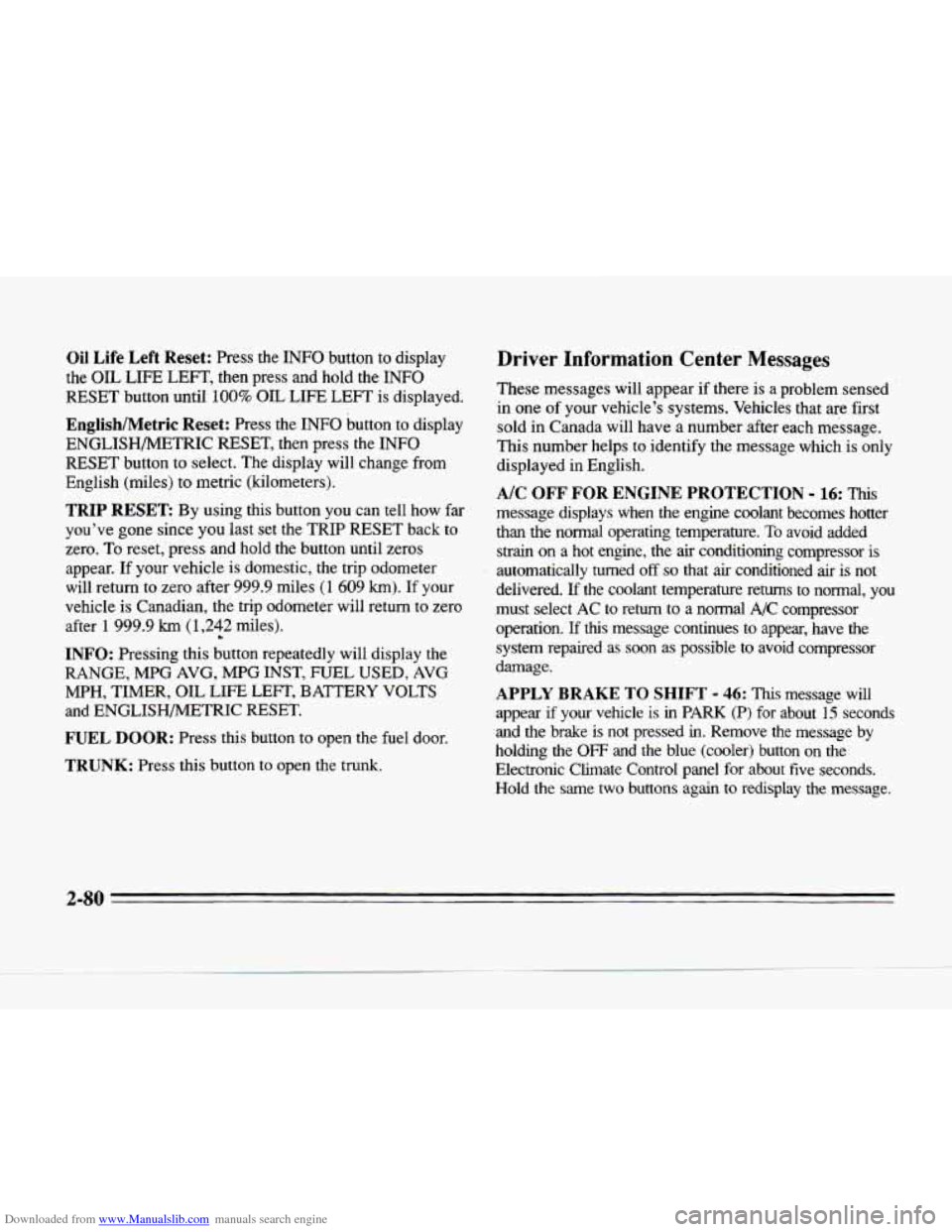
Downloaded from www.Manualslib.com manuals search engine Oil Life Left Reset: Press the INFO button to display
the
OIL LIFE LEFT, then press and hold the INFO
RESET button until
100% OIL LIFE LEFT is displayed.
English/Metric Reset: Press the INFO button to display
ENGLISHMETRIC
RESET, then press the INFO
RESET button to select. The display will change from
English (miles) to metric (kilometers).
TRIP RESET By using this button you can tell how far
you've gone since you last set the TRIP RESET back to
zero. To reset,' press and hold the button until zeros
appear.
If your vehicle is domestic, the trip odometer
will return to zero after 999.9 miles
(1 609 km). If your
vehicle is Canadian, the trip odometer will return to zero
after
1 999.9 km (1,242 L miles).
INFO: Pressing this button repeatedly will display the
RANGE, MPG AVG, MPG INST, FUEL USED, AVG
MPH, TIMER, OIL LIFE LEFT, BATTERY VOLTS
and ENGLISHMETRIC RESET.
FUEL DOOR: Press this button to open the fuel door.
TRUNK: Press this button to open the trunk.
Driver Information Center Messages
These messages will appear if there is a problem sensed
in one
of your vehicle's systems. Vehicles that are first
sold in Canada will have a number after each message.
This number helps to identify the message which is only
displayed in English.
message displays when the engine coolant becomes hotter
than the normal operating temperature.
To avoid added
strain on a hot engine, the air conditioning compressor is
automatically turned off so that air conditioned air is not
delivered.
If the coolant temperature rems to normal, you
must select
AC to return to a normal A/C compressor
operation.
If this message continues to appear, have the
system repaired as soon as possible to avoid compressor
damage.
A/C OFF FOR ENGINE PROTECTION - 16: "his
APPLY BRAKE TO SHIFT - 46: This message will
appear if your vehicle is in PARK (P) for about 15 seconds
and
the brake is not pressed in. Remove the message by
holding the
OFF and the blue (cooler) button on the
Electronic Climate Control panel for about five seconds.
Hold the same two buttons again to redisplay
the message.
2-80
Page 145 of 354
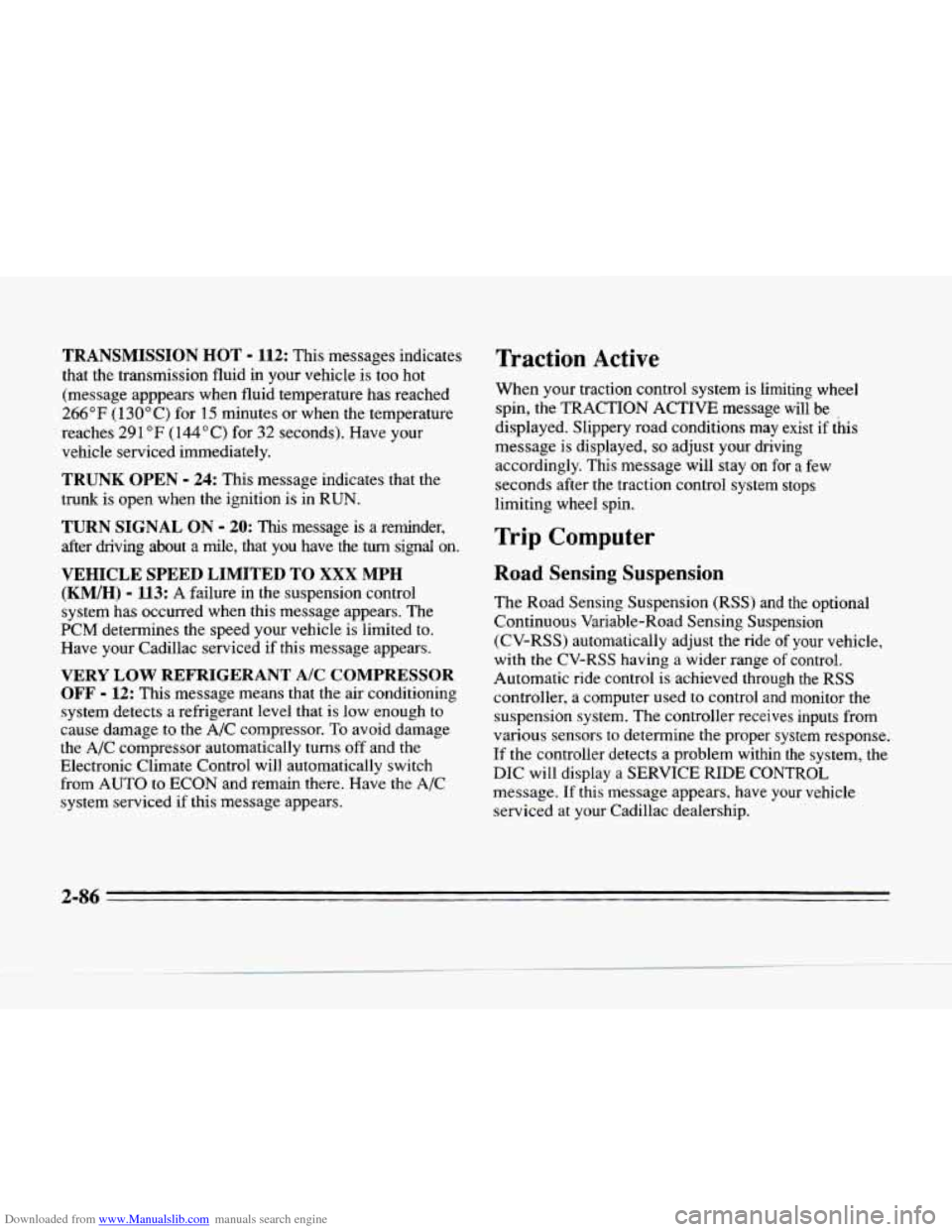
Downloaded from www.Manualslib.com manuals search engine TRANSMISSION HOT - 112: This messages indicates
that the transmission fluid in your vehicle is too hot
(message apppears when fluid temperature has reached
266°F (1 30°C) for 15 minutes or when the temperature
reaches
291 OF (144°C) for 32 seconds). Have your
vehicle serviced immediately.
TRUNK OPEN - 24: This message indicates that the
trunk
is open when the ignition is in RUN.
TURN SIGNAL ON - 20: This message is a reminder,
after driving about
a mile, that you have the turn signal on.
VEHICLE SPEED LIMITED TO XXX MPH
(KM/H) - 113: A failure in the suspension control
system has occurred when this message appears. The
PCM determines the speed your vehicle is limited to.
Have your Cadillac serviced if this message appears.
VERY LOW REFRIGERANT A/C COMPRESSOR
OFF - 12: This message means that the air conditioning
system detects a refrigerant level that is
low enough to
cause damage to
the A/C compressor. To avoid damage
the
A/C compressor automatically turns off and the
Electronic Climate Control will automatically switch
from
AUTO to ECON and remain there. Have the A/C
system serviced if this message appears.
Traction Active
When your traction control system is limiting wheel
spin, the TRACTION ACTIVE message will be
displayed. SIippery road conditions may exist
if this
message is displayed,
so adjust your driving
accordingly. This message will stay
on for a few
seconds after the traction control system stops
limiting wheel spin.
Trip Computer
Road Sensing Suspension
The Road Sensing Suspension (RSS) and the optional
Continuous Variable-Road Sensing Suspension
(CV-RSS) automatically adjust the ride
of your vehicle,
with the CV-RSS having
a wider range of control.
Automatic ride control is achieved through the
RSS
controller, a computer used to control and monitor the
suspension system. The controller receives inputs from
various sensors
to determine the proper system response.
If the controller detects a problem
within the system, the
DIC will display
a SERVICE RIDE CONTROL
message. If this message appears, have your vehicle
serviced at your Cadillac dealership.
2-86
Page 149 of 354
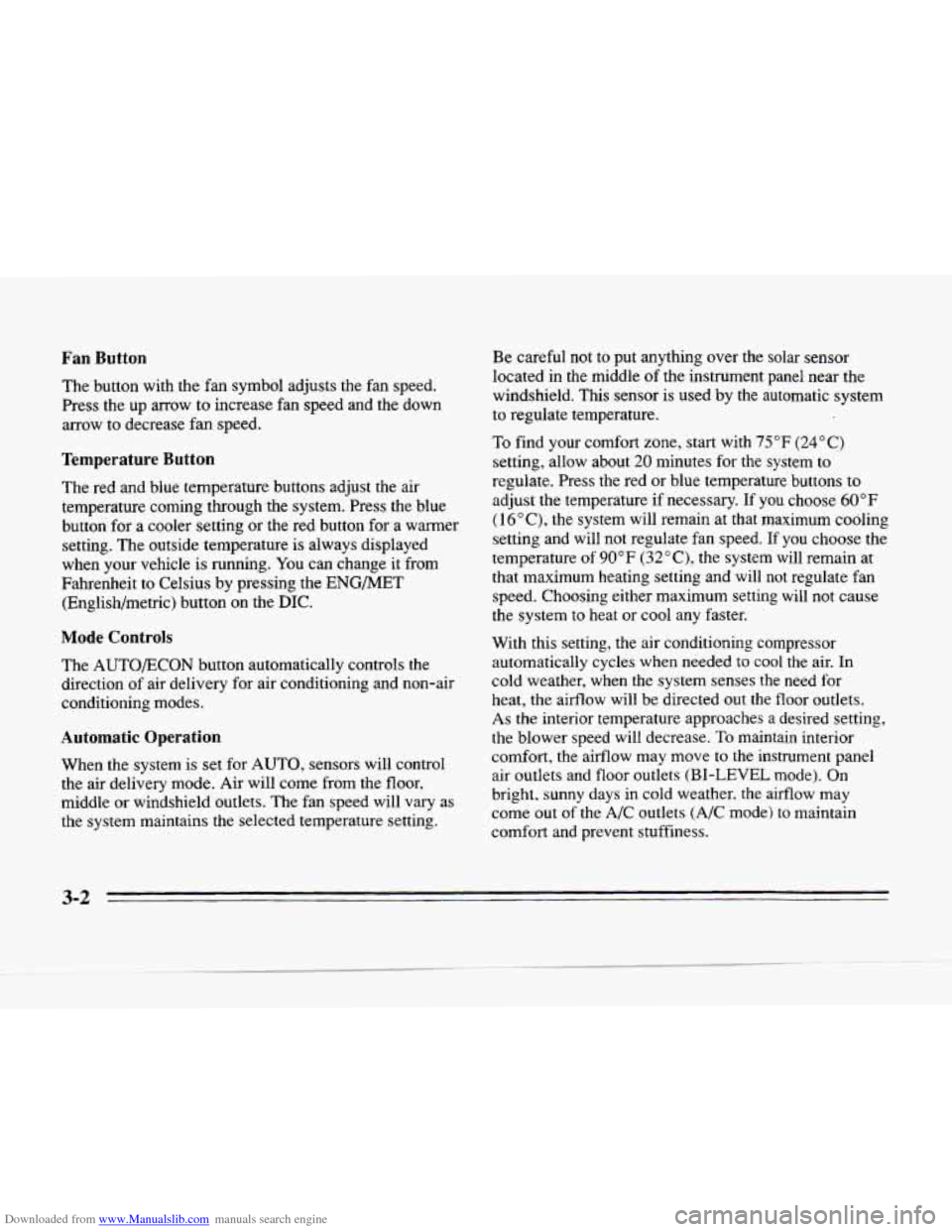
Downloaded from www.Manualslib.com manuals search engine Fan Button
The button with the fan symbol adjusts the fan speed.
Press the up arrow to increase fan speed and the down
arrow to decrease fan speed.
Temperature Button
The red and blue temperature buttons adjust the air
temperature coming through the system. Press the blue
button for
a cooler setting or the red button for a warmer
setting. The outside temperature
is always displayed
when your vehicle
is running. You can change it from
Fahrenheit
to Celsius by pressing the ENG/MET
(English/metric) button on the
DIC.
Mode Controls
The AUTO/ECON button automatically controls the
direction of air delivery for air conditioning and non-air
conditioning modes.
Automatic Operation
When the system is set for AUTO, sensors will control
the air delivery mode. Air will come from the
floor,
middle or windshield outlets. The fan speed will vary as
the system maintains the selected temperature setting. Be
careful not
to put anything over the solar sensor
located in the middle of the instrument panel near the
windshield. This sensor is used by the automatic system
to regulate temperature.
To find your comfort zone, start with
75°F (24°C)
setting, allow about 20 minutes for the system to
regulate. Press the red or blue temperature buttons to
adjust the temperature if necessary. If you choose 60°F
(1 6"C), the system will remain at that maximum cooling
setting and will not regulate fan speed.
If you choose the
temperature
of 90°F (32 "C), the system will remain at
that maximum heating setting and will not regulate fan
speed. Choosing either maximum setting will not cause
the system
to heat or cool any faster.
With this setting, the air conditioning compressor
automatically cycles when needed to
cool the air. In
cold weather, when the system senses the need for
heat, the airflow will be directed
out the floor outlets.
As the interior temperature approaches a desired setting,
the blower speed will decrease.
To maintain interior
comfort, the airflow may move
to the instrument panel
air outlets and floor outlets
(BI-LEVEL mode). On
bright, sunny days in cold weather, the airflow may
come
out of the A/C outlets (A/C mode) to maintain
comfort and prevent stuffiness.
3-2
Page 154 of 354
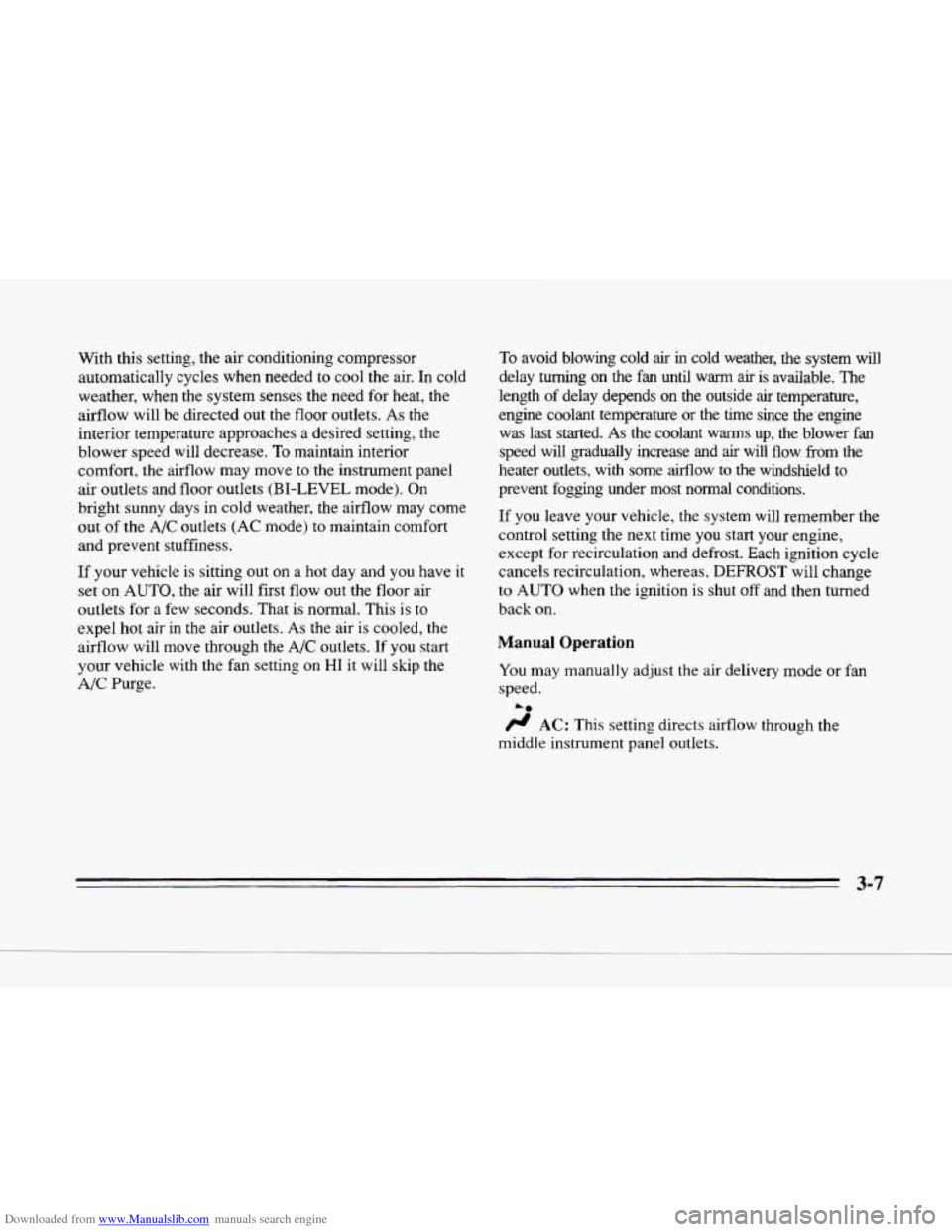
Downloaded from www.Manualslib.com manuals search engine c
c
With this setting, the air conditioning compressor
automatically cycles when needed to cool the air.
In cold
weather, when the system senses the need for heat, the
airflow will be directed out
the floor outlets. As the
interior temperature approaches a desired setting, the
blower speed
will decrease. To maintain interior
comfort, the airflow may move
to the instrument panel
air outlets and floor outlets
(BI-LEVEL mode). On
bright sunny days in cold weather, the airflow may come
out
of the A/C outlets (AC mode) to maintain comfort
and prevent stuffiness.
If your vehicle is sitting
out on a hot day and you have it
set on AUTO, the air will first flow out the floor air
outlets for a few seconds. That is normal. This
is to
expel hot air in the air outlets. As the air is cooled, the
airflow will move through the A/C outlets. If you start
your vehicle
with the fan setting on HI it will skip the
A/C Purge.
To avoid blowing cold air in cold weather, the system will
delay turning on the fan until warm
air is available. The
length of delay depends on the outside
air temperature,
engine coolant temperature or the time since the'engine
was last started.
As the coolant warms up, the blower fan
speed will gradually increase and
air will flow from the
heater outlets, with some airflow to the windshield to
prevent fogging under most normal conditions.
If you leave your vehicle, the system will remember the
control setting the next time you start your engine,
except for recirculation and defrost. Each ignition cycle
cancels recirculation, whereas,
DEFROST will change
to AUTO when the ignition is shut off and then turned
back
on.
Manual Operation
You may manually adjust the air delivery mode or fan
speed.
be
/I AC: This setting directs airflow through the
middle instrument panel outlets.
3-7
Page 156 of 354
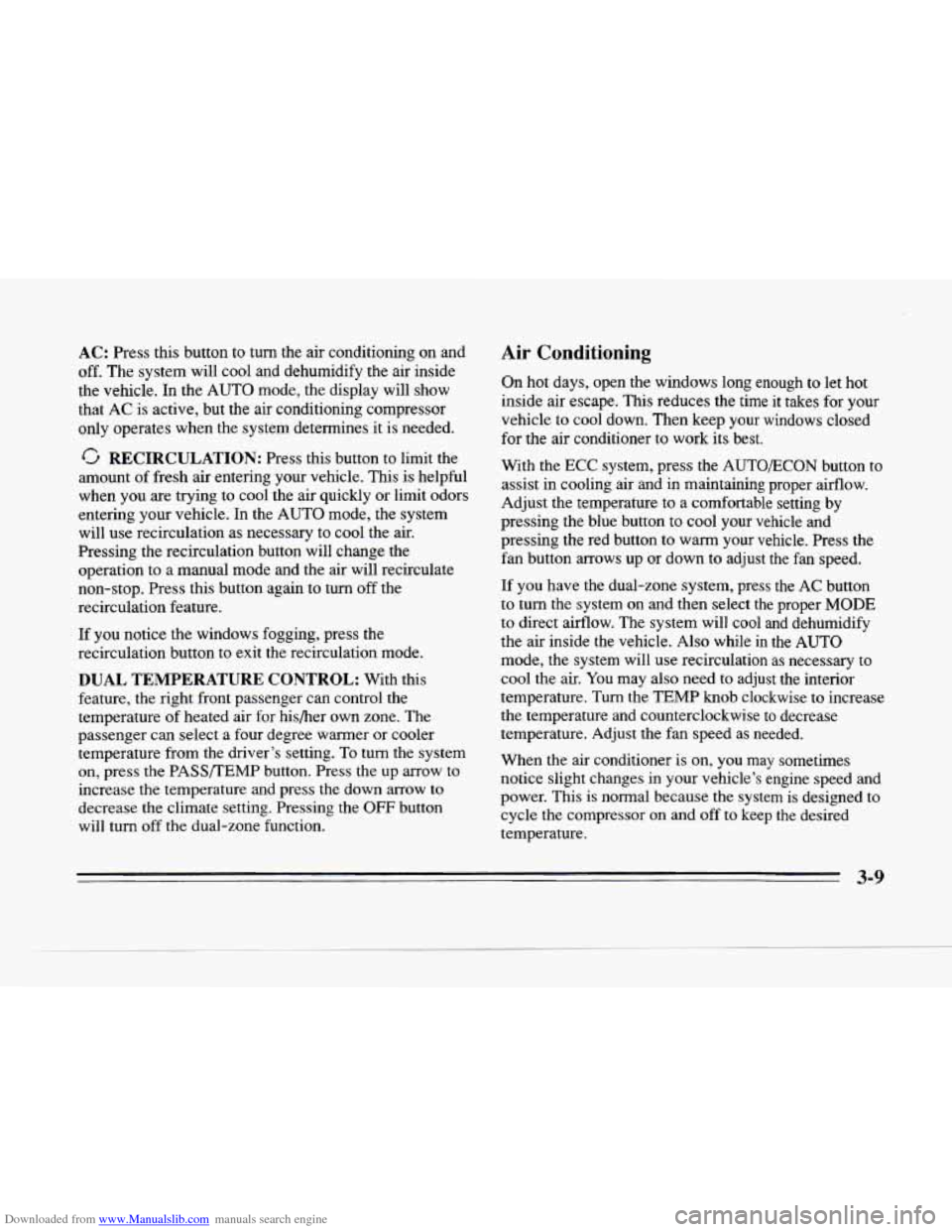
Downloaded from www.Manualslib.com manuals search engine AC: Press this button to turn the air conditioning on and
off.
The system will cool and dehumidify the air inside
the vehicle. In the AUTO mode, the display will show
that AC is active, but the air conditioning compressor
only operates when the system determines it is needed.
RECIRCULATION: Press this button to limit the
amount of fresh air entering your vehicle. This is helpful
when you
are trying to cool the air quickly or limit odors
entering your vehicle. In the AUTO mode, the system
will use recirculation as necessary to cool the
air.
Pressing the recirculation button will change the
operation to a manual mode and the air will recirculate
non-stop. Press this button again to turn off the
recirculation feature.
If you notice the windows fogging, press
the
recirculation button to exit the recirculation mode.
DUAL TEMPERATURE CONTROL: With this
feature, the right front passenger can control the
temperature of heated air for hisher own zone. The
passenger can select a four degree warmer or cooler
temperature from the driver’s setting.
To turn the system
on, press the PASS/TEMP button. Press the up arrow to
increase
the temperature and press the down arrow to
decrease the climate setting. Pressing the
OFF button
will turn off the dual-zone function.
Air Conditioning
On hot days, open the windows long enough to let hot
inside air escape. This reduces the time it takes for your
vehicle to cool down. Then keep your windows closed
for the
air conditioner to work its best.
With the
ECC system, press the AUTO/ECON button to
assist in cooling air and
in maintaining proper airflow.
Adjust the temperature to a comfortable setting by
pressing the blue button to cool your vehicle and
pressing the red button to warm your vehicle. Press the
fan button arrows up or down to adjust the fan speed.
If you have the dual-zone system, press the AC button
to turn the system on and then select
the proper MODE
to direct airflow. The system will cool and dehumidify
the air inside the vehicle. Also while in the AUTO
mode, the system will use recirculation as necessary to
cool the air. You may also need to adjust the interior
temperature. Turn the TEMP knob clockwise to increase
the temperature and counterclockwise
to decrease
temperature. Adjust the fan speed as needed.
When the air conditioner .is on, you may sometimes
notice slight changes in your vehicle’s engine speed and
power. This is normal because the system is designed to
cycle the compressor
on and off to keep the desired
temperature.
3-9
Page 157 of 354
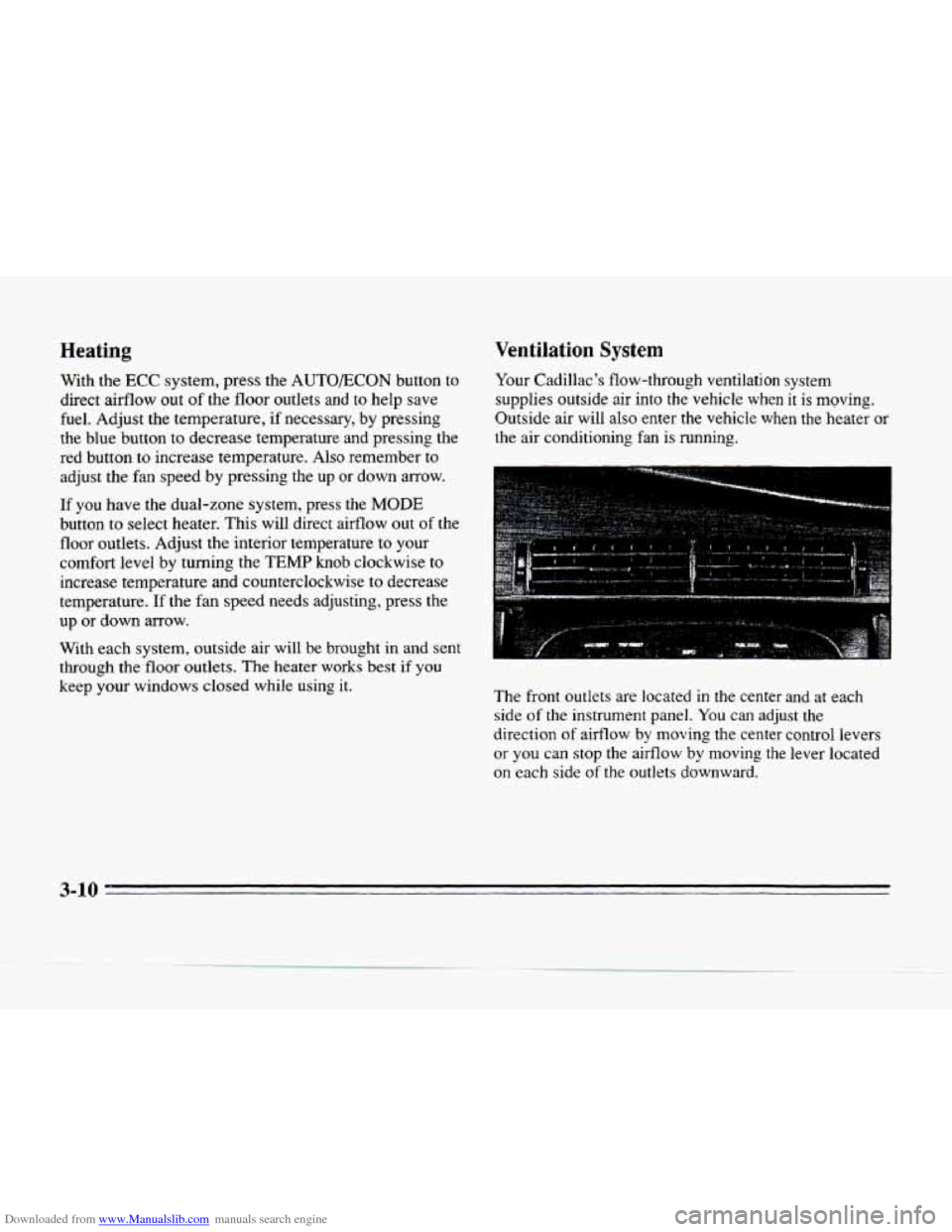
Downloaded from www.Manualslib.com manuals search engine Heating Ventilation System
With
the ECC system, press the AUTOECON button to
direct airflow out
of the floor outlets and to help save
fuel. Adjust the temperature,
if necessary, by pressing
the blue button
to decrease temperature and pressing the
red button
to increase temperature. Also remember to
adjust the fan speed by pressing the up or down arrow.
If you have the dual-zone system, press the MODE
button to select heater. This will direct airflow out of the
floor outlets. Adjust the interior temperature to your
comfort level by turning the
TEMP knob clockwise to
increase temperature and counterclockwise to decrease
temperature. If the fan speed needs adjusting, press the
up or down arrow.
With each system, outside air will be brought in and sent
through the
floor outlets. The heater works best if you
keep your windows closed while using it. Your
Cadillac’s flow-through ventilation system
supplies outside air into
the vehicle when it is moving.
Outside air will also enter the vehicle when the heater
or
the air conditioning fan is running.
The front outlets
are located in the center and at each
side
of the instrument panel. You can adjust the
direction
of aifflow by moving the center control levers
or
you can stop the airflow by moving the lever located
on each side
of the outlets downward.
3-10
Page 324 of 354
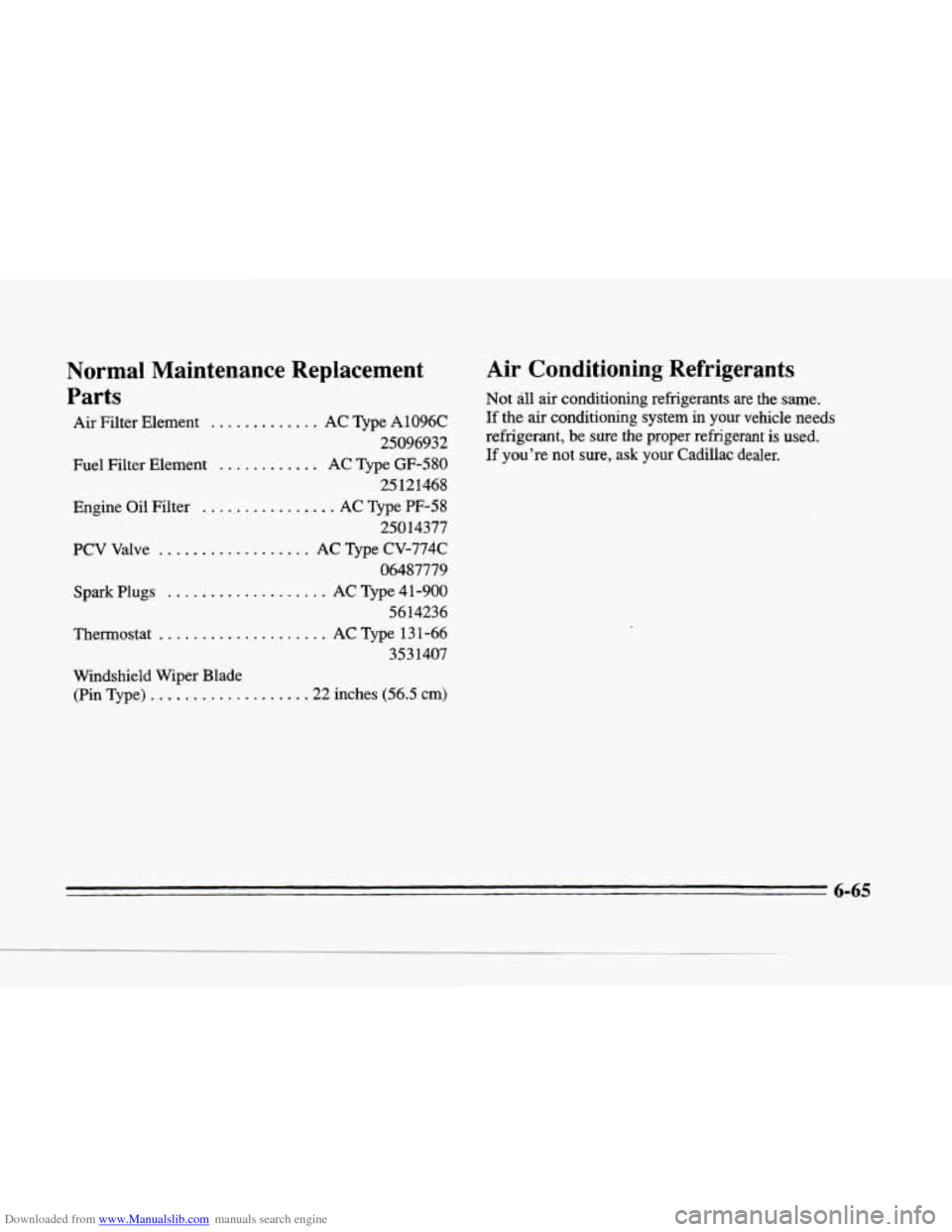
Downloaded from www.Manualslib.com manuals search engine c
LI
Normal Maintenance Replacement Parts
Air Filter Element .............
Fuel Filter Element ............
AC Type A1096C
25096932
AC Type GF-580 25121468
Engine Oil Filter
................ AC Type PF-58
25014377
PCV Valve
.................. AC Type CV-774C
06487779
Spark
Plugs ................... AC Type 4 1-900
5614236
Thermostat
.................... AC Type 13 1-66
3531407
Air Conditioning Refrigerants
Not all air conditioning refrigerants are the same.
If the air conditioning system in your vehicle needs
refrigerant, be sure the proper refrigerant
is used.
If you’re not sure, ask your Cadillac dealer.
Windshield Wiper Blade
(Pin Type)
.................. .22 inches (56.5 cm)
6-65
Page 342 of 354
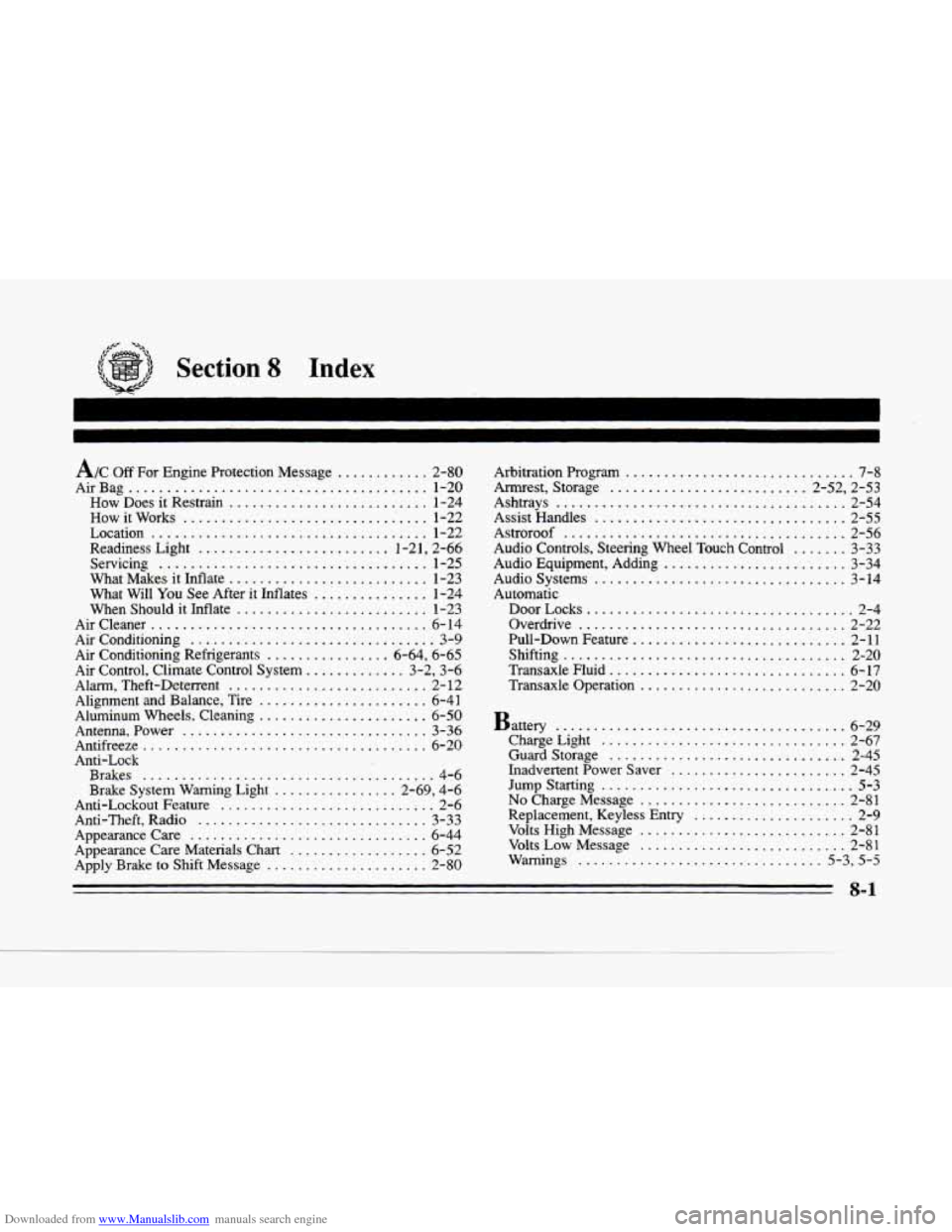
Downloaded from www.Manualslib.com manuals search engine Section 8 Index
.
Y
..
.
A/C Off For Engine Protection Message ............ 2-80
AirBag
....................................... 1-20
How Does it Restrain
.......................... 1-24
How it Works
................................ 1-22
Location
.................................... 1-22
Readiness Light
......................... 1.21. 2.66
Servicing
................................... 1-25
What Makes it Inflate
.......................... 1-23
What Will
You See After it Inflates ............... 1-24
When Should it Inflate ......................... 1-23
Aircleaner
.................................... 6-14
Air Conditioning
................................ 3-9
Air Conditioning Refrigerants ................ 6.64. 6.65
Air Control
. Climate Control System ............. 3.2. 3-6
Alarm. Theft-Deterrent .......................... 2-12
Alignment and Balance. Tire
...................... 6-41
Aluminum Wheels
. Cleaning ...................... 6-SO
Antenna. Power
................................ 3-36
Antifreeze ..................................... 6-20
Anti-Lock Brakes
...................................... 4-6
Brake System Warning Light
................ 2.69. 4.6
Anti-Lockout Feature
............................ 2-6
Anti.Theft. Radio
.............................. 3-33
Appearance Care
............................... 6-44
Appearance Care Materials Chart
.................. 6-52
Apply Brake to
Shift Message ..................... 2-80 Arbitration Program
.............................. 7-8
Armrest. Storage
.......................... 2.52. 2.53
Ashtrays
...................................... 2-54
Assist Handles
................................. 2-55
Astroroof
..................................... 2-56
Audio Controls. Steering Wheel Touch Control
....... 3-33
Audio Equipment. Adding
........................ 3-34
Audio Systems
................................. 3-14
Automatic DoorLocks
................................... 2-4
Overdrive
................................... 2-22
Pull-Down Feature
............................ 2-11
Shifting
..................................... 2-20
Transaxle Fluid
............................... 6-17
Transaxle Operation
........................... 2-20
Battery
...................................... 6-29
ChargeLight
................................ 2-67
Guard Storage
............................... 2-45
Inadvertent Power Saver
....................... 2-45
Jump Starting ................................. 5-3
No
Charge Message ........................... 2-81
Replacement. Keyless Entry
..................... 2-9
Volts High Message
........................... 2-81
Volts Low Message
........................... 2-81
Warnings
................................ 5-3. 5-5
8-1
Page 349 of 354
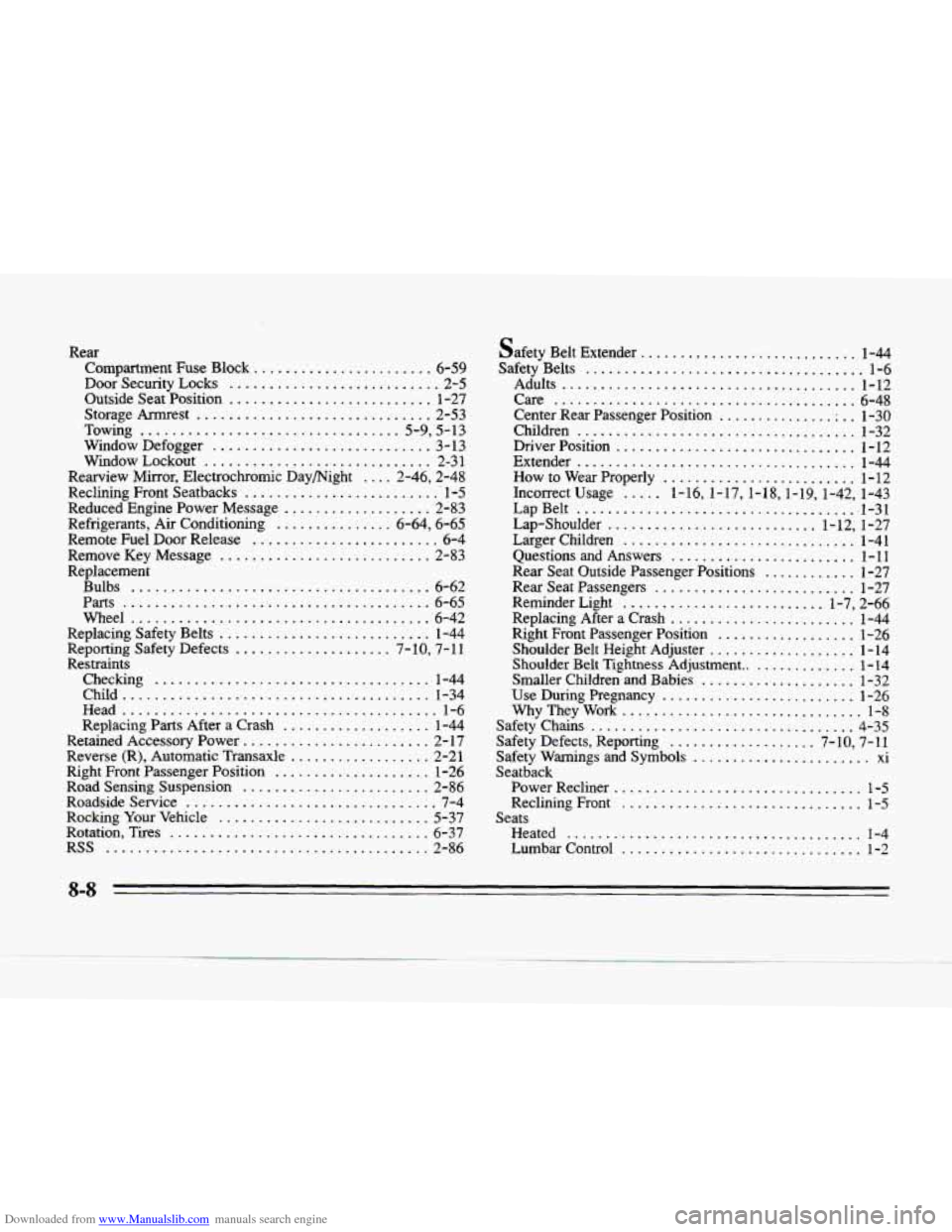
Downloaded from www.Manualslib.com manuals search engine Rear Compartment Fuse Block ....................... 6-59
Outside Seat Position .......................... 1-27
Storage Armrest
.............................. 2-53
Window Defogger
............................ 3- 13
Window Lockout
............................. 2-31
Reduced Engine Power Message
................... 2-83
Refrigerants, Air Conditioning
............... 6-64, 6-65
Remote Fuel Door Release
........................ 6-4
Remove Key Message
........................... 2-83
DoorSecurityLocks
........................... 2-5
Towing
................................. 5-9, 5-13
Rearview Mirror, Electrochromic Daymight
.... 2-46, 2-48
Reclining Front Seatbacks
.......................... 1-5
Replacement Bulbs
...................................... 6-62
Parts
....................................... 6-65
Wheel
...................................... 6-42
Replacing Safety Belts ........................... 1-44
Reporting Safety Defects
.................... 7-10, 7-11
Restraints Checking
................................... 1-44
Child
....................................... 1-34
Head
.,..................................... l-6
Replacing Parts After a Crash ................... 1-44
Retained Accessory Power
........................ 2-17
Reverse (R), Automatic Transaxle
.................. 2-21
Right Front Passenger Position
.................... 1-26
Road Sensing Suspension
........................ 2-86
Roadside Service
................................ 7-4
Rocking
Your Vehicle ........................... 5-37
Rotation, Tires
................................. 6-37
RSS
......................................... 2-86 Safety
Belt Extender
............................ 1-44
Safety Belts
.................................... 1-6
Adults
...................................... 1-12
Care
....................................... 6-48
Center Rear Passenger Position
............... : .. 1-30
Children
.................................... l-32
Driver Position ............................... 1-12
Extender
.................................... 1-44
How to Wear Properly
......................... 1-12
Incorrect Usage
..... 1-16, 1-17, 1-18,l-19, 1-42, 1-43
Lap Belt
...................................... 1-31
Lap-Shoulder
........................... 1-12, 1-27
Larger Children
.............................. 1-41
Questions
and Answers ........................ 1-11
Rear Seat Outside Passenger Positions
............ 1-27
Rear Seat Passengers
.......................... 1-27
Reminder Light
.......................... 1-7, 2-66
Replacing After
a Crash ........................ 1-44
Right Front Passenger Position
.................. 1-26
Shoulder Belt Height Adjuster
................... 1-14
Shoulder Belt Tightness Adjustment
............... 1-14
Smaller Children and Babies
.................... 1-32
Use During Pregnancy ......................... 1-26
Safety Chains
.................................. 4-35
Safety Defects, Reporting
................... 7-10, 7-11
Safety Warnings
and Symbols ....................... xi
Power Recliner ................................ 1-5
Reclining Front
............................... 1-5
Lumbar Control
............................... 1-2
WhyTheyWork
............................... 1-8
Seatback
Seats Heated
...................................... 1-4
8-8